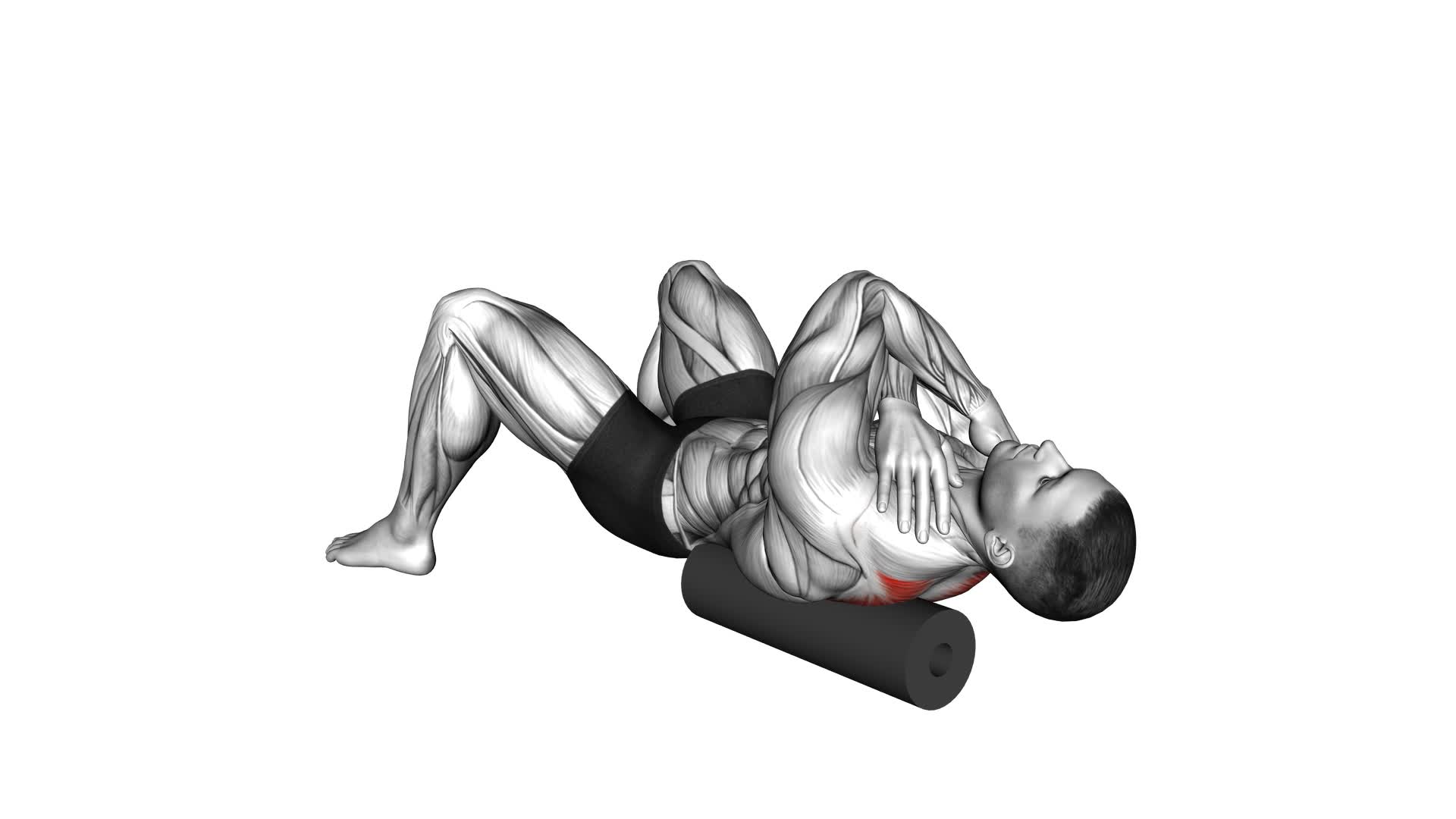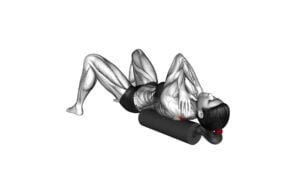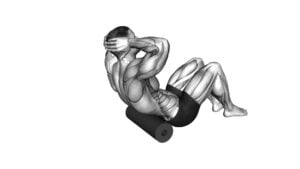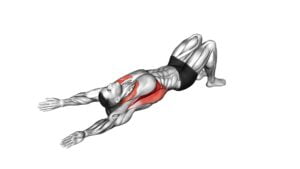Roll Rhomboids – Video Exercise Guide & Tips

Looking to strengthen your rhomboids? Look no further than the Roll Rhomboids exercise.
Watch This Exercise Video
In this video exercise guide, we'll walk you through proper form, technique, and variations to help you maximize your results.
Avoid common mistakes and get the most out of your workout with our helpful tips.
Get ready to roll your way to stronger rhomboids!
Key Takeaways
- Roll rhomboids improves posture, strengthens the upper back, and targets the rhomboid muscles.
- Proper form and technique include maintaining tall, upright posture, keeping the spine straight and shoulders relaxed, and engaging core muscles for stability.
- Using a foam roller enhances the exercise effectiveness by adding instability, increasing intensity, allowing for greater range of motion, and releasing tension in surrounding muscles.
- Progressions and variations can be incorporated to challenge muscles and avoid plateaus, such as using a weighted roller, performing the exercise on unstable surfaces, trying different arm positions, and targeting different areas of the upper back and shoulders.
Benefits of Roll Rhomboids
To maximize your workout, incorporating the roll rhomboids exercise can provide numerous benefits. This exercise focuses on improving posture and strengthening the upper back. By targeting the rhomboid muscles, located between your shoulder blades, you can enhance your overall posture and prevent the slouching that often occurs from prolonged sitting or poor posture habits.
The roll rhomboids exercise involves using a foam roller or a rolled-up towel to target the muscles in your upper back. To perform this exercise, lie on your back with the foam roller positioned horizontally beneath your shoulder blades. Bend your knees and place your feet flat on the floor. Slowly roll back and forth, applying gentle pressure to the muscles in your upper back. Focus on releasing tension and tightness as you roll.
By regularly incorporating the roll rhomboids exercise into your workout routine, you can strengthen the muscles that support proper posture. This can help alleviate back pain and prevent future injuries. Additionally, by improving your posture, you can enhance your overall appearance and confidence.
Proper Form and Technique
To ensure you perform the roll rhomboids exercise correctly, follow these guidelines for proper form and technique.
Proper alignment is crucial for getting the most out of this exercise and avoiding injury. One common misconception is that rolling the shoulders forward and hunching the back is the correct way to perform the exercise. However, this can actually strain the muscles and lead to poor results. Instead, focus on maintaining a tall, upright posture throughout the movement. Keep your spine straight and your shoulders relaxed.
Another important aspect of proper form is to engage your core muscles. This will help stabilize your body and prevent any unnecessary strain on the back. To engage your core, simply draw your belly button towards your spine and maintain this contraction throughout the exercise.
Equipment and Setup
Now let's talk about what equipment you'll need and how to set it up for the roll rhomboids exercise.
While the roll rhomboids exercise can be performed without any specific equipment, using a foam roller can greatly enhance the effectiveness of the exercise. Using a foam roller provides several benefits.
First, it helps to increase the intensity of the exercise by adding an element of instability. This requires your muscles to work harder to maintain balance and stability.
Second, the foam roller allows for a greater range of motion, allowing you to target your rhomboid muscles more effectively.
Finally, using a foam roller can help to release tension and tightness in the muscles surrounding the rhomboids, promoting better overall muscle health.
To set up for the roll rhomboids exercise, you'll need a foam roller and a flat, open space. Begin by placing the foam roller on the floor perpendicular to your body. Sit on the foam roller with your knees bent and feet flat on the floor.
Position the foam roller between your shoulder blades, leaning back slightly to support your weight. Place your hands behind your head or cross them over your chest. This is your starting position.
Progressions and Variations
For added difficulty and variety, incorporate different exercises into your roll rhomboids routine. Progressions and modifications are key to creating effective workout routines.
One way to progress your roll rhomboids exercise is by using a weighted roller. By adding weight to the roller, you increase the resistance and challenge your muscles even more.
Another variation is to perform the exercise on an unstable surface, such as a stability ball or a BOSU ball. This will engage your core muscles and improve your balance and stability.
Additionally, you can incorporate different arm positions into your roll rhomboids routine. For example, you can try performing the exercise with your arms extended overhead or with your elbows bent and your hands behind your head. These variations will target different areas of your upper back and shoulders.
By incorporating progressions and modifications into your roll rhomboids routine, you can continue to challenge your muscles and avoid plateaus.
Now let's move on to the next section, where we'll discuss common mistakes to avoid.
Common Mistakes to Avoid
Make sure you avoid these common mistakes when performing the roll rhomboids exercise. Proper form is essential to prevent injuries and maximize the effectiveness of the exercise.
One common mistake is using too much momentum. Remember to control the movement throughout the exercise, focusing on engaging your rhomboid muscles. Avoid swinging your body or using your legs to generate momentum.
Another mistake to avoid is hunching your shoulders. Keep your shoulders down and back, maintaining a neutral spine position. This will ensure that you're targeting the correct muscles and avoiding unnecessary strain on your neck and shoulders.
Additionally, be mindful of your breathing. Many people tend to hold their breath during exercises, which can lead to tension and decreased performance. Take deep breaths in and out as you roll your shoulders, allowing your muscles to receive the oxygen they need.
Tips for Maximizing Results
To maximize your results while performing the roll rhomboids exercise, it's important to employ efficient workout techniques.
This means focusing on proper form and engaging the targeted muscle groups effectively.
Efficient Workout Techniques
Maximize your workout results with efficient techniques.
One effective method is high intensity interval training (HIIT), which involves alternating between short bursts of intense exercise and brief periods of rest or active recovery. HIIT not only burns more calories during the workout but also increases your metabolism, allowing you to continue burning calories even after you're done exercising.
Another efficient technique is incorporating compound exercises into your routine. These exercises target multiple muscle groups at once, saving you time and maximizing the effectiveness of your workout. Examples of compound exercises include squats, deadlifts, and push-ups.
Targeting Specific Muscle Groups
Target your rhomboids effectively with the roll exercise to maximize results. Strengthening your rhomboids is essential for maintaining good posture and preventing back pain.
Here are some tips to help you target your back muscles effectively:
- Incorporate rhomboid strengthening exercises into your workout routine, such as the roll exercise.
- Focus on proper form and technique to ensure that you're targeting the rhomboids specifically.
- Gradually increase the intensity and resistance of your exercises to continually challenge and strengthen your back muscles.
Targeting your rhomboids and other back muscles is important for overall strength and stability. By incorporating specific exercises into your routine and paying attention to proper form, you can maximize your results and maintain a strong and healthy back.
Avoiding Common Mistakes
To avoid common mistakes and maximize your results, it's important to focus on proper form and technique when performing the roll exercise to strengthen your rhomboids.
One common mistake to avoid is using momentum to roll your shoulder blades. Instead, engage your rhomboids by initiating the movement from your back muscles. Keep your core engaged and your spine aligned throughout the exercise.
Another mistake is neglecting the full range of motion. Make sure to roll your shoulder blades all the way down and then back up, feeling the stretch and contraction in your rhomboids.
Lastly, avoid excessive tension in your neck and shoulders. Relax your upper body and focus on isolating the movement to your rhomboids.
Frequently Asked Questions
How Many Sets and Reps Should I Do When Performing the Roll Rhomboids Exercise?
When performing the roll rhomboids exercise, it's important to consider how many sets and reps to do.
To progress in this exercise, start with 2-3 sets of 8-12 reps, gradually increasing as you get stronger.
Avoid common mistakes like using momentum or shrugging your shoulders.
Focus on engaging your rhomboid muscles and maintaining proper form.
Can the Roll Rhomboids Exercise Be Modified for Individuals With Limited Mobility?
Modified variations of the roll rhomboids exercise can be beneficial for individuals with limited mobility. By making adjustments to the range of motion or using props for support, you can still engage the targeted muscles while accommodating your specific needs. These modifications can be especially helpful for seniors who may have mobility restrictions.
It's important to consult with a qualified fitness professional to ensure proper form and technique when performing modified variations of the roll rhomboids exercise.
Is It Necessary to Warm up Before Doing the Roll Rhomboids Exercise?
Before doing the roll rhomboids exercise, it's important to warm up. Warming up helps to increase blood flow to your muscles, making them more flexible and less prone to injury. It also prepares your body for the exercise by increasing your heart rate and loosening your joints.
Stretching before the roll rhomboids exercise is also beneficial as it helps to improve your range of motion and prevent muscle strain. So, make sure to incorporate a warm-up and stretching routine before starting the roll rhomboids exercise.
Can the Roll Rhomboids Exercise Help With Posture Correction?
The roll rhomboids exercise can definitely help with posture correction. By incorporating this exercise into your daily routine, you can strengthen your rhomboid muscles, which are responsible for pulling your shoulder blades together. This can help improve your posture and prevent slouching.
To perform the roll rhomboids exercise properly, sit with your back straight and roll your shoulders back, squeezing your shoulder blades together. Repeat this motion for maximum effectiveness.
What Muscles Are Targeted When Performing the Roll Rhomboids Exercise?
When you perform the roll rhomboids exercise, you target the rhomboid muscles in your upper back. These muscles are responsible for retracting and stabilizing your shoulder blades. By strengthening the rhomboids, you can improve your posture and reduce the risk of shoulder and neck pain.
The roll rhomboids exercise can also help to counteract the effects of slouching and sitting for long periods of time. Overall, it's a beneficial exercise for promoting better posture and muscle balance.
Conclusion
In conclusion, roll rhomboids is a highly beneficial exercise for targeting and strengthening the rhomboid muscles.
By following proper form and technique, using the appropriate equipment and setup, and avoiding common mistakes, you can maximize the results of this exercise.
Whether you're a beginner or advanced, there are progressions and variations available to challenge yourself further.
Incorporating roll rhomboids into your fitness routine can help improve your posture, upper back strength, and overall shoulder stability.

Author
Years ago, the spark of my life’s passion ignited in my mind the moment I stepped into the local gym for the first time. The inaugural bead of perspiration, the initial endeavor, the very first surge of endorphins, and a sense of pride that washed over me post-workout marked the beginning of my deep-seated interest in strength sports, fitness, and sports nutrition. This very curiosity blossomed rapidly into a profound fascination, propelling me to earn a Master’s degree in Physical Education from the Academy of Physical Education in Krakow, followed by a Sports Manager diploma from the Jagiellonian University. My journey of growth led me to gain more specialized qualifications, such as being a certified personal trainer with a focus on sports dietetics, a lifeguard, and an instructor for wellness and corrective gymnastics. Theoretical knowledge paired seamlessly with practical experience, reinforcing my belief that the transformation of individuals under my guidance was also a reflection of my personal growth. This belief holds true even today. Each day, I strive to push the boundaries and explore new realms. These realms gently elevate me to greater heights. The unique combination of passion for my field and the continuous quest for growth fuels my drive to break new ground.







